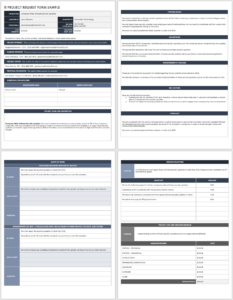Standardized documentation facilitates efficient communication between stakeholders, reduces ambiguity, and streamlines the evaluation and prioritization of proposed improvements. This organized approach promotes better tracking of requests, minimizes miscommunication, and ultimately contributes to more effective system evolution. The use of a standardized form can also aid in impact analysis and resource allocation.
The following sections will delve into the specific components of a well-designed form, explore best practices for its implementation, and discuss strategies for maximizing its effectiveness within an organization.
Key Components of a System Enhancement Request Form
Effective forms incorporate several key elements to ensure clarity and completeness. These components facilitate a thorough understanding of the proposed enhancement and its potential impact.
1. Requestor Information: This section identifies the individual or team submitting the request, providing contact information for follow-up and clarification.
2. Date of Request: Timestamping the submission allows for tracking and prioritization based on submission date.
3. System/Application Impacted: Clearly specifying the affected system ensures the request reaches the appropriate personnel and reduces ambiguity.
4. Current Behavior Description: A detailed explanation of the existing functionality serves as a baseline for understanding the proposed change.
5. Proposed Enhancement Description: This section outlines the desired changes to the system, including specific functionalities and expected outcomes.
6. Justification/Business Case: A clear rationale for the enhancement, including the benefits and potential return on investment, helps justify the allocation of resources.
7. Expected Impact: An assessment of the potential effects of the enhancement on other systems, processes, and users is crucial for comprehensive planning.
8. Priority Level: Assigning a priority level (e.g., high, medium, low) assists in prioritizing requests based on urgency and business impact.
Careful attention to these elements ensures that requests are well-defined, readily understood, and effectively processed. This structure facilitates informed decision-making and efficient allocation of resources for system improvements.
How to Create a System Enhancement Request Template
Creating a standardized template ensures consistent and complete requests, facilitating efficient processing and implementation of system improvements. A well-designed template guides requestors through providing the necessary information for thorough evaluation.
1. Define Objectives: Clearly outline the goals and purpose of the template. Determine the specific information required to assess enhancement requests effectively.
2. Determine Required Fields: Include essential fields such as requestor information, date, system affected, current behavior description, proposed enhancement description, justification, expected impact, and priority level.
3. Design the Layout: Organize the fields logically to facilitate clear and concise communication. Use headings, subheadings, and clear labels to guide the user.
4. Choose a Format: Select an accessible format, such as a word document, spreadsheet, or online form, that allows for easy completion and distribution.
5. Establish a Review Process: Define a clear workflow for reviewing and approving submitted requests. Specify roles and responsibilities for evaluating and prioritizing enhancements.
6. Implement and Train: Introduce the template to all stakeholders and provide training on its proper use. Ensure users understand the importance of complete and accurate information.
7. Regularly Review and Update: Periodically review the template’s effectiveness and make necessary revisions to ensure it continues to meet organizational needs. Adapt the template to accommodate evolving system requirements and user feedback.
A well-defined template, coupled with a robust review process, contributes significantly to effective system evolution. Standardization ensures clarity, completeness, and facilitates informed decision-making for continuous improvement.
Standardized forms for requesting system enhancements provide a crucial framework for managing proposed changes effectively. From facilitating clear communication and streamlined processing to enabling informed decision-making and efficient resource allocation, these tools play a vital role in driving successful system evolution. Key components such as detailed descriptions of current and proposed behaviors, justifications, impact assessments, and priority levels ensure comprehensive documentation. Establishing a well-defined creation process, incorporating essential fields, and implementing a robust review workflow are crucial steps for maximizing the benefits of these structured requests. Regular review and adaptation of the template are essential for maintaining alignment with evolving organizational needs and system requirements.
Leveraging structured templates empowers organizations to navigate the complexities of system enhancements strategically. The methodical approach fostered by these forms contributes to improved communication, better resource management, and ultimately, more effective and responsive systems that meet evolving business demands. Embracing a standardized approach to system enhancement requests paves the way for continuous improvement and optimized technological advancement.

